Spatial Pattern of Large-Scale Agricultural Land and Spatial Heterogeneity of Influencing Factors in the Mountainous Areas of Western China—Wuling Mountains as an Example
Abstract
:1. Introduction
2. Theoretical Framework
3. Materials and Methods
3.1. Study Area
3.2. Data Sources and Data Processing
3.2.1. Data Sources
3.2.2. Data Processing
3.3. Methodology
3.3.1. Kernel Density Analysis Method
3.3.2. Spatial Autocorrelation Analysis
3.3.3. Geographic Detector
3.3.4. Geographical Weighted Regression Model
3.3.5. Traffic Accessibility Calculation
4. Result
4.1. Spatial Pattern Characteristics of Large-Scale Agricultural Land in the Wuling Mountains
4.1.1. Spatial Distribution Pattern of Agricultural Land of Different Types and Scales
4.1.2. Spatial Distribution Characteristics of Large-Scale Agricultural Land at County Scale
4.1.3. Spatial Autocorrelation Analysis of Large-Scale Agricultural Land
4.2. Analysis of Influencing Factors of Spatial Pattern of Large-Scale Agricultural Land in the Wuling Mountains Area
4.2.1. Geographical Exploration of Influencing Factors of Scaling Agricultural Land
4.2.2. Spatial Heterogeneity Analysis of Influencing Factors of Large-scale Agricultural Land
5. Discussion
5.1. Analysis of the Mechanism of Factors Influencing Scale Agricultural Land from the Perspective of Spatial Heterogeneity
5.2. Policy Implication
5.3. Limitations and Future Development Direction
6. Conclusions
Author Contributions
Funding
Data Availability Statement
Conflicts of Interest
References
- Song, X.Q. Discussion on land use transition research framework. Acta Geogr. Sin. 2017, 72, 471–487. [Google Scholar]
- Foley, J.A. Global Consequences of Land Use. Science 2005, 309, 570–574. [Google Scholar] [CrossRef] [PubMed]
- Wen, T.J.; Lau, K.; Cheng, C.W.; He, H.L.; Qiu, J.S. Ecological Civilization, Indigenous Culture, and Rural Reconstruction in China. Mon. Rev. 2012, 63, 29–35. [Google Scholar]
- Drummond, M.A.; Griffith, G.E.; Auch, R.F.; Stier, M.P.; Taylor, J.L.; Hester, D.J.; Riegle, J.L.; McBeth, J.L. Understanding recurrent land use processes and long-term transitions in the dynamic south-central United States, c. 1800 to 2006. Land Use Policy 2017, 68, 345–354. [Google Scholar] [CrossRef]
- Levers, C.; Muller, D.; Erb, K.; Haberl, H.; Jepsen, M.R.; Metzger, M.J.; Meyfroidt, P.; Plieninger, T.; Plutzar, C.; Sturck, J.; et al. Archetypical patterns and trajectories of land systems in Europe. Reg. Environ. Change 2018, 18, 715–732. [Google Scholar] [CrossRef]
- Karayalcin, C.; Pintea, M. The role of productivity, transportation costs, and barriers to intersectoral mobility in structural transformation. Econ. Model. 2022, 108, 105759. [Google Scholar] [CrossRef]
- Jianping, Y.; Lei, F.; Yan, J.; Prosterman, R.; Keliang, Z. Survey of rural land use rights in China in 2008—Survey results and policy recommendations in 17 provinces. Manag. World 2010, 64–73. [Google Scholar] [CrossRef]
- Wang, Y.; Li, X.; Xin, L.; Tan, M.; Jiang, M. Regional differences of land circulation in China and its drivers: Based on 2003–2013 rural fixed observation points data. J. Geogr. Sci. 2018, 28, 707–724. [Google Scholar] [CrossRef]
- Liang, X.Y.; Li, Y.B. Spatio-temporal features of scaling farmland and its corresponding driving mechanism in Three Gorges Reservoir Area. J. Geogr. Sci. 2019, 29, 563–580. [Google Scholar] [CrossRef]
- Wang, J.Y.; Li, X.; Xin, L. Spatial-temporal Variations and Influential Factors of Land Transfer in China. J. Nat. Resour. 2018, 33, 2067–2083. [Google Scholar]
- Zhang, L.; Feng, S.Y.; Qu, F.T. Regional Differences of Farmland Transfer and Its Influencing Factors: A Case Study of Jiangsu Province. China Land Sci. 2014, 28, 73–80. [Google Scholar] [CrossRef]
- Yayun, W.; Yinying, C.; Haiyan, L. The Status of Farmland Transfer in the Context of Spatial Heterogeneity and Its Influencing Factors: Case Studies in Wuhan, Jingmen and Huanggang. China Land Sci. 2015, 29, 18–25. [Google Scholar]
- Hongmei, X.; Yan, G.; Zhigang, L.; Sainan, L.; Juanqiong, L. Spatio-temporal characteristics of farmland circulation and influencing factors in metropolitan suburbs: A case study of Caidian District, Wuhan City. Sci. Geogr. Sin. 2020, 40, 2055–2063. [Google Scholar] [CrossRef]
- Hongmei, X.; Guo, Y.; Zhigang, L.; Ningning, Z.; Sainan, L. Spatial patterns of farmland transfer and the mechanisms from the perspective of capital cycle: A case study of Caidian, Wuhan city. Geogr. Res. 2021, 40, 994–1007. [Google Scholar]
- Hongyu, R. Cultivated land fragmentation in mountainous areas based on different resolution images and its scale effects. Geogr. Res. 2020, 39, 1283–1293. [Google Scholar]
- Xiaobin, L.J.J. Influence mechanism of cultivated land fragmentation on sustainable intensification and its governance framework. Acta Geogr. Sin. 2022, 77, 2703–2719. [Google Scholar]
- Yangbing, L.X.L. Traditional agroecosystem transition in mountainous area of Three Gorges Reservoir Area. Acta Geogr. Sin. 2019, 74, 1605–1621. [Google Scholar]
- Shuang, C.; Yangbing, L.; Mingzhen, L. Evolution pattern and driving mechanism in farmland of scale on town level: A case study of Fengjie County in Chongqing. Mt. Res. 2021, 39, 101–116. [Google Scholar] [CrossRef]
- Li, F.; Feng, S.Y.; Lu, H.L.; Qu, F.T.; D’Haese, M. How do non-farm employment and agricultural mechanization impact on large-scale farming? A spatial panel data analysis from Jiangsu Province, China. Land Use Policy 2021, 107, s0264837721002404. [Google Scholar] [CrossRef]
- Qiu, T.W.; Luo, B.L.; Geng, P.P.; Zhu, M.D. Market-oriented land rentals in the less-developed regions of China. Appl. Econ. Lett. 2021, 28, 945–948. [Google Scholar] [CrossRef]
- Qian, L.; Lu, H.; Gao, Q.; Lu, H.L. Household-owned farm machinery vs. outsourced machinery services: The impact of agricultural mechanization on the land leasing behavior of relatively large-scale farmers in China. Land Use Policy 2022, 115, 106008. [Google Scholar] [CrossRef]
- Qiu, T.W.; Ma, X.L.; Luo, B.L.; Choy, S.T.B.; He, Q.Y. Land defragmentation in China: Does rental transaction inside acquaintance networks matter? J. Appl. Econ. 2022, 25, 259–278. [Google Scholar] [CrossRef]
- Qiu, T.W.; Zhang, D.R.; Choy, S.T.B.; Luo, B.L. The interaction between informal and formal institutions: A case study of private land property rights in rural China. Econ. Anal. Policy 2021, 72, 578–591. [Google Scholar] [CrossRef]
- Yamauchi, F. Rising real wages, mechanization and growing advantage of large farms: Evidence from Indonesia. Food Policy 2016, 58, 62–69. [Google Scholar] [CrossRef]
- Lyu, L.G.; Gao, Z.B.; Long, H.L.; Wang, X.R.; Fan, Y.T. Farmland Use Transition in a Typical Farming Area: The Case of Sihong County in the Huang-Huai-Hai Plain of China. Land 2021, 10, 347. [Google Scholar] [CrossRef]
- Meng, B.; Wang, X.X.; Zhang, Z.F.; Huang, P. Spatio-Temporal Pattern and Driving Force Evolution of Cultivated Land Occupied by Urban Expansion in the Chengdu Metropolitan Area. Land 2022, 11, 1458. [Google Scholar] [CrossRef]
- Wang, W.W.; Gong, J.; Wang, Y.; Shen, Y. Exploring the effects of rural site conditions and household livelihood capitals on agricultural land transfers in China. Land Use Policy 2021, 108, 105523. [Google Scholar] [CrossRef]
- Wang, S.T.; Bai, X.M.; Zhang, X.L.; Reis, S.; Chen, D.L.; Xu, J.M.; Gu, B.J. Urbanization can benefit agricultural production with large-scale farming in China. Nat. Food 2021, 2, 183–191. [Google Scholar] [CrossRef]
- Long, H.L. Theorizing land use transitions: A human geography perspective. Habitat Int. 2022, 128, 102669. [Google Scholar] [CrossRef]
- Zhang, F.W.; Bao, X.L.; Deng, X.; Xu, D.D. Rural Land Transfer in the Information Age: Can Internet Use Affect Farmers’ Land Transfer-In? Land 2022, 11, 1761. [Google Scholar] [CrossRef]
- Zou, B.L.; Mishra, A.K. How internet use affects the farmland rental market: An empirical study from rural China. Comput. Electron. Agric. 2022, 198, 107075. [Google Scholar] [CrossRef]
- Yin, H.; Huo, P.; Wang, S. Agricultural and Rural Digital Transformation: Realistic Representation, Impact Mechanism and Promotion Strategy. Reform 2020, 12, 48–56. [Google Scholar]
- Berchoux, T.; Watmough, G.R.; Hutton, C.W.; Atkinson, P.M. Agricultural shocks and drivers of livelihood precariousness across Indian rural communities. Landsc. Urban Plan. 2019, 189, 307–319. [Google Scholar] [CrossRef]
- Branco, J.E.H.; Bartholomeu, D.B.; Alves, P.N.; Caixeta, J.V. Mutual analyses of agriculture land use and transportation networks: The future location of soybean and corn production in Brazil. Agric. Syst. 2021, 194, 103264. [Google Scholar] [CrossRef]
- Chen, Y. Revitalization and linkage planning of ethnic villages and towns from the perspective of “three exchanges”—Taking Wuling Mountain Area as an example. J. South Central Univ. Natl. (Humanit. Soc. Sci. Ed.) 2021, 41, 32–38. [Google Scholar] [CrossRef]
- Chen, Y.; Liu, Y.L.; Yang, S.F.; Liu, C.W. Impact of Land-Use Change on Ecosystem Services in the Wuling Mountains from a Transport Development Perspective. Int. J. Environ. Res. Public Health 2023, 20, 1323. [Google Scholar] [CrossRef]
- Li, M.Z.; Xie, Y.X.; Li, Y.B. Transition of rural landscape patterns in Southwest China’s mountainous area: A case study based on the Three Gorges Reservoir Area. Environ. Earth Sci. 2021, 80, 742. [Google Scholar] [CrossRef]
- Mengqin, H.; Yangbing, L.; Caihong, R. Dynamic changes and transformation of agricultural landscape pattern in mountainous areas. Acta Geogr. Sin. 2021, 76, 2749–2764. [Google Scholar]
- Yu, M.; Li, Y.B.; Luo, G.J.; Yu, L.M.; Chen, M. Agroecosystem composition and landscape ecological risk evolution of rice terraces in the southern mountains, China. Ecol. Indic. 2022, 145, 109625. [Google Scholar] [CrossRef]
- Jiao, Y.M. Spatial Pattern and Farming Radius of Hani’s Settlementsin Ailao Mountain Using GIS. Resour. Sci. 2006, 28, 66–72. [Google Scholar]
- Huang, M.Q.; Li, Y.B.; Ran, C.H.; Li, M.Z. Dynamic changes and transitions of agricultural landscape patterns in mountainous areas: A case study from the hinterland of the Three Gorges Reservoir Area. J. Geogr. Sci. 2022, 32, 1039–1058. [Google Scholar] [CrossRef]
- Anselin, L. Local Indicators of Spatial Association—LISA. Geogr. Anal. 1995, 27, 93–115. [Google Scholar] [CrossRef]
- Moran, P.A.P. Notes on Continuous Stochastic Phenomena. Biometrika 1950, 37, 17–23. [Google Scholar] [CrossRef] [PubMed]
- Chen, W.X.; Yang, L.Y.; Wu, J.H.; Wu, J.H.; Wang, G.Z.; Bian, J.J.; Zeng, J.; Liu, Z.L. Spatio-temporal characteristics and influencing factors of traditional villages in the Yangtze River Basin: A Geodetector model. Herit. Sci. 2023, 11, 111. [Google Scholar] [CrossRef]
- Griffith, D.A. Spatial-filtering-based contributions to a critique of geographically weighted regression (GWR). Environ. Plan. Econ. Space 2008, 40, 2751–2769. [Google Scholar] [CrossRef]
- Feng, Z.M.; Liu, D.; Yang, Y. Evaluation of transportation accessibility in China: From county to province. Geogr. Res. 2009, 28, 419–429. [Google Scholar]
- Chen, W.X.; Zeng, Y.Y.; Zeng, J. Impacts of traffic accessibility on ecosystem services: An integrated spatial approach. J. Geogr. Sci. 2021, 31, 1816–1836. [Google Scholar] [CrossRef]
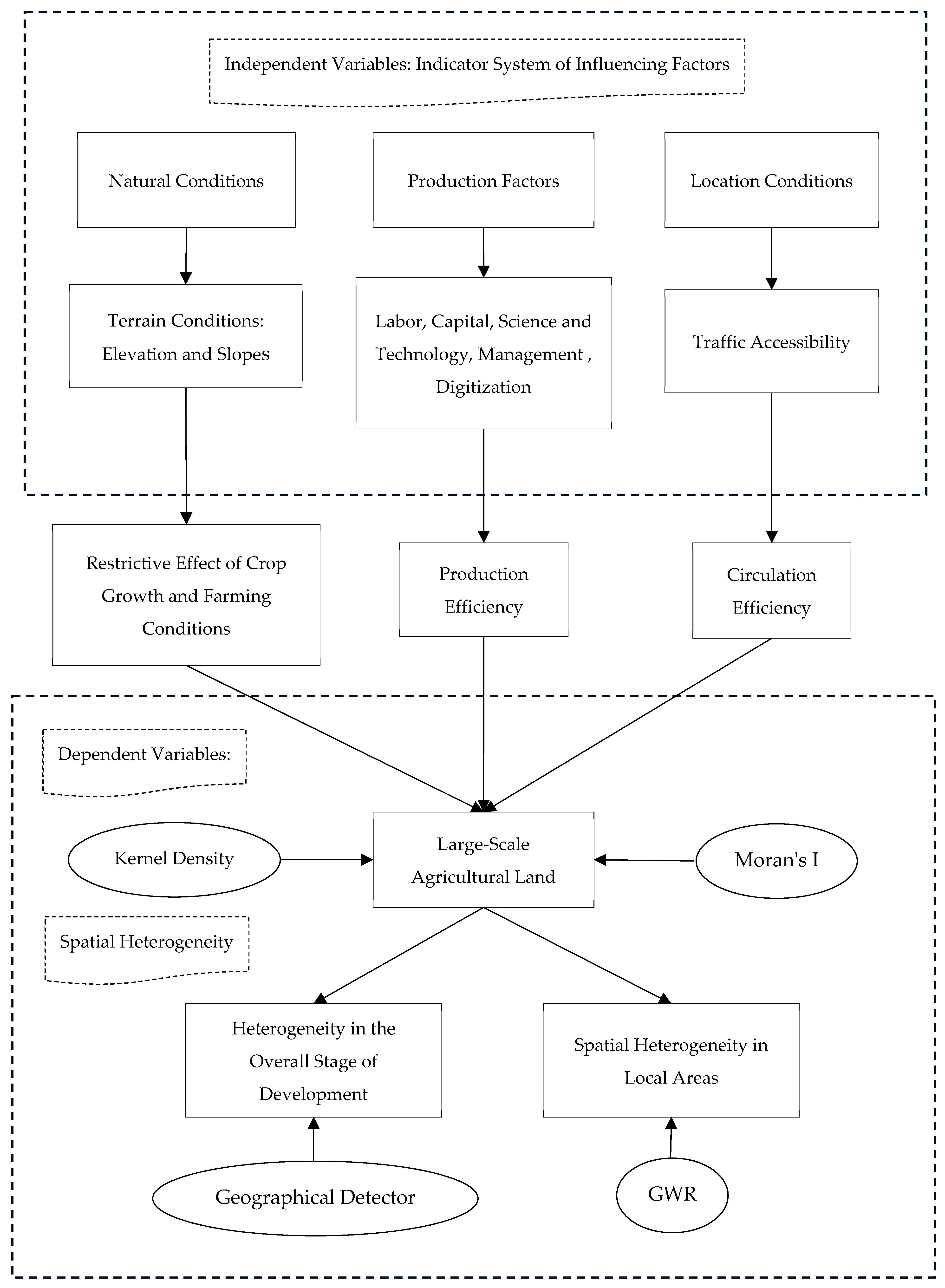
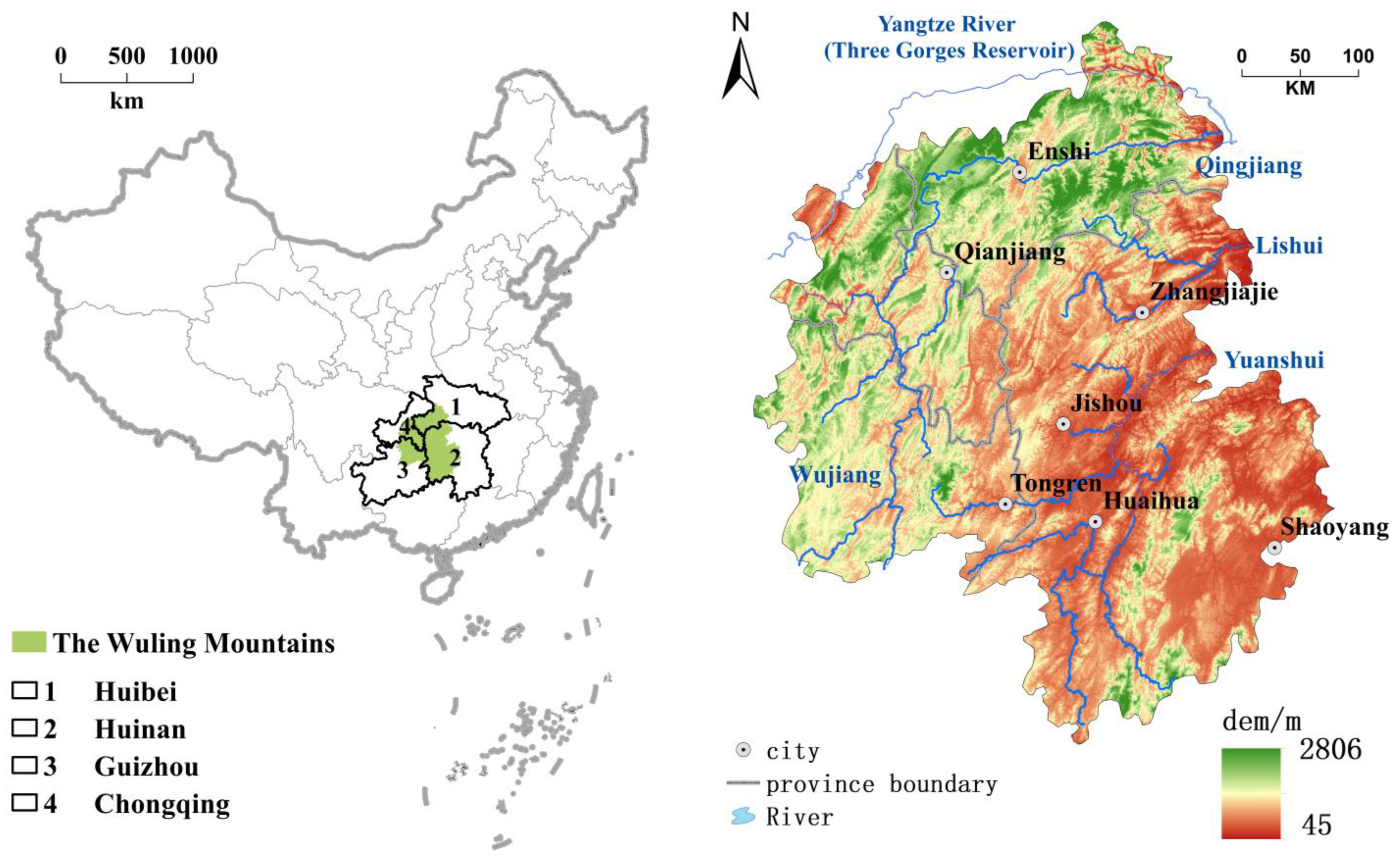
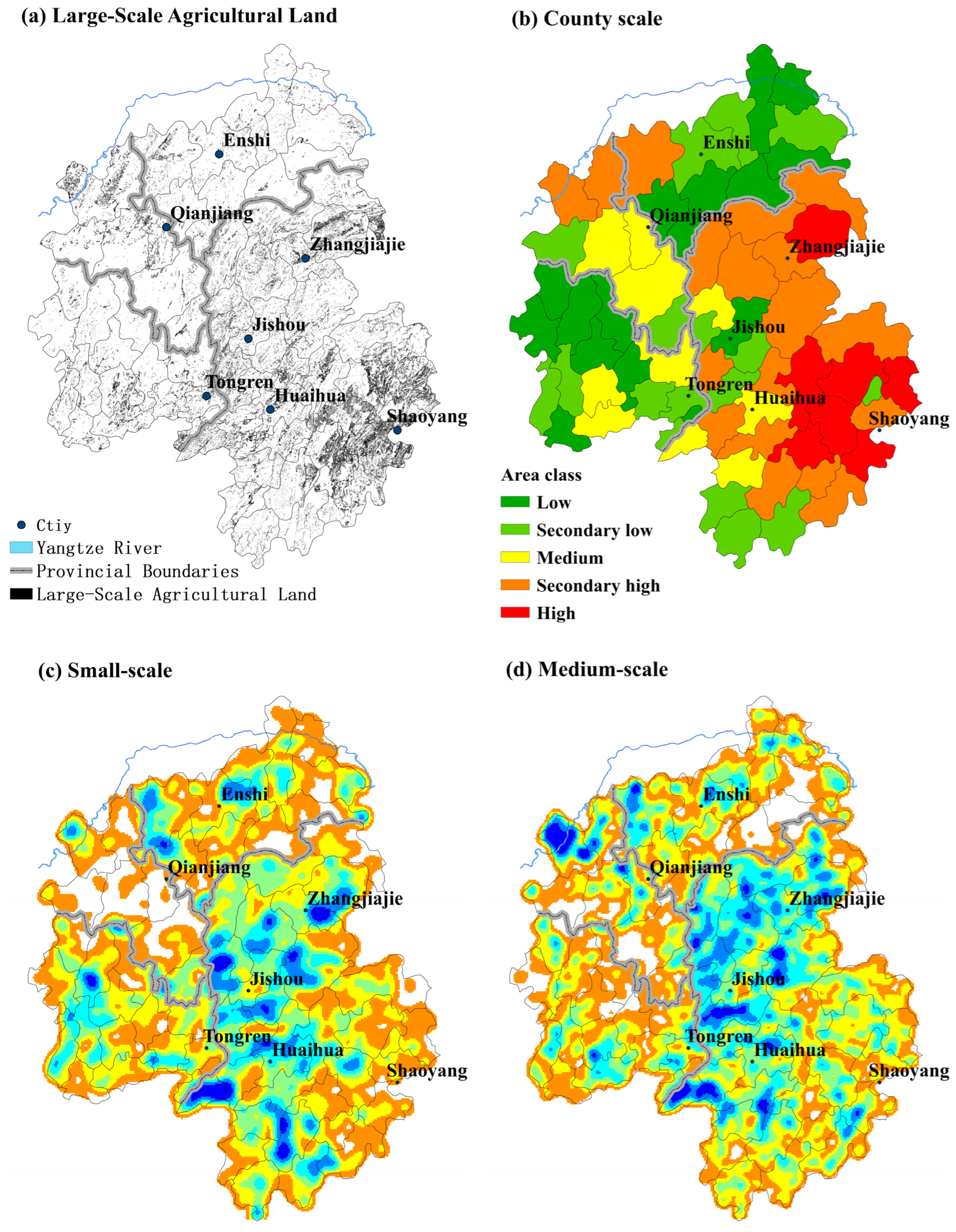
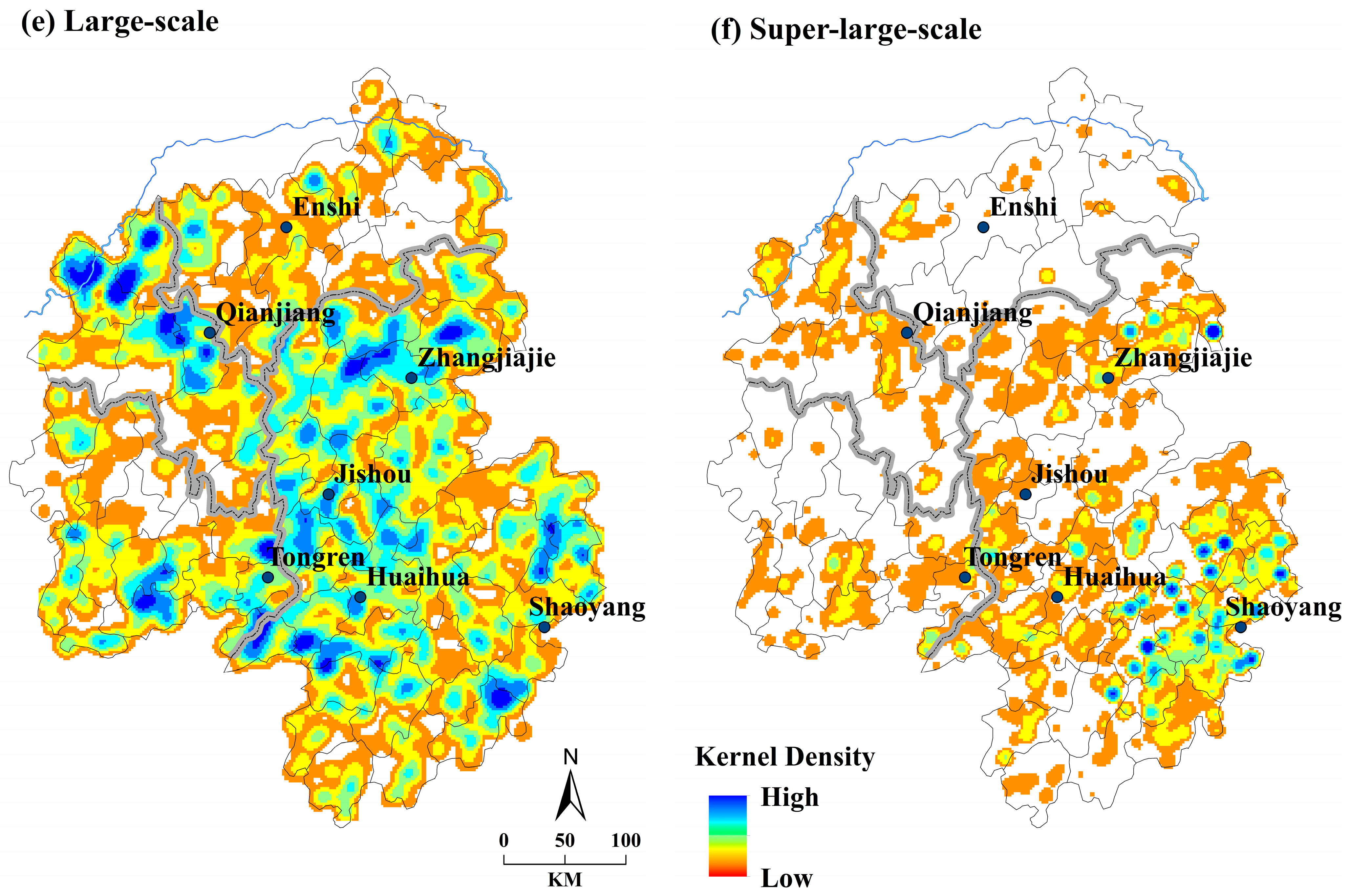
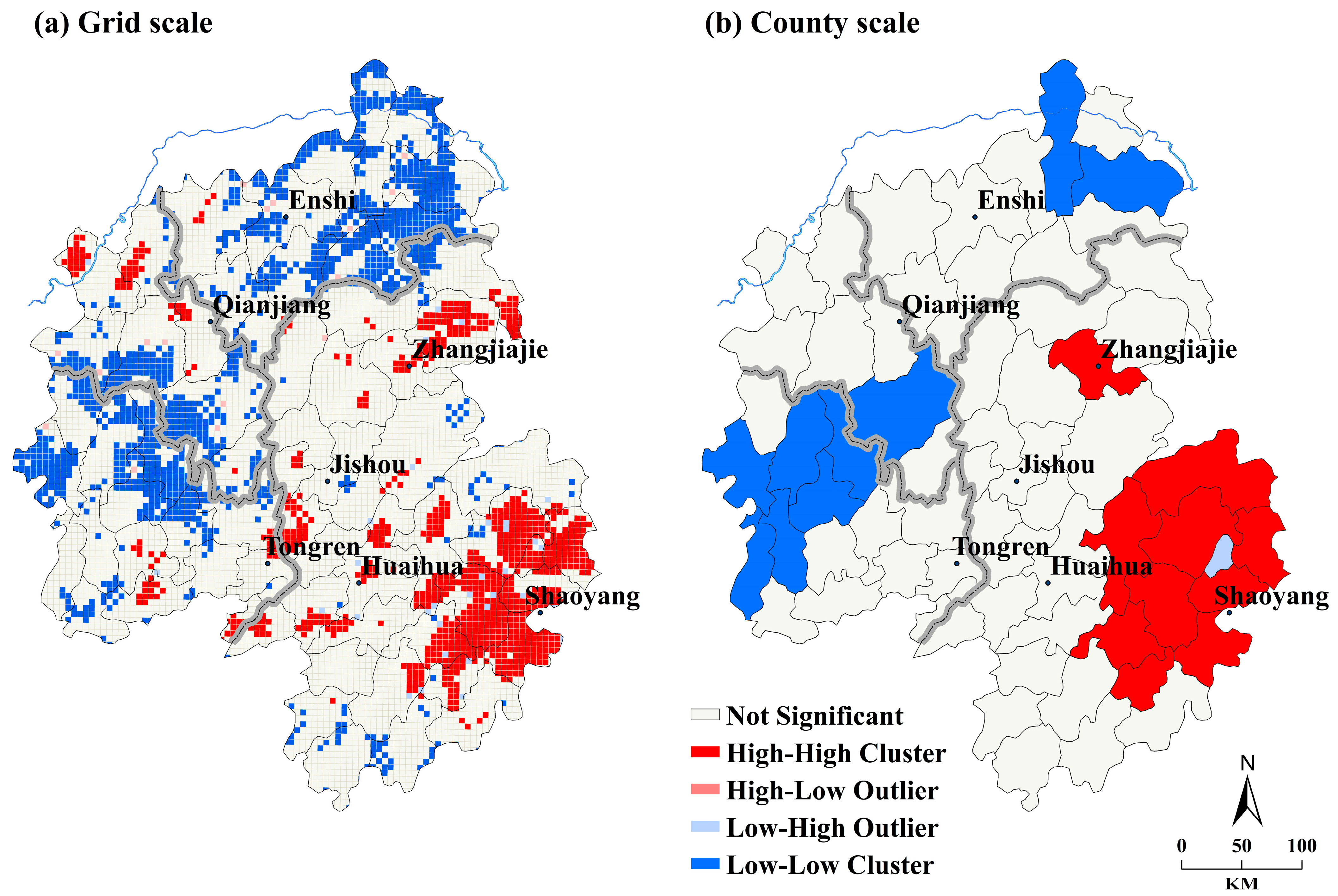
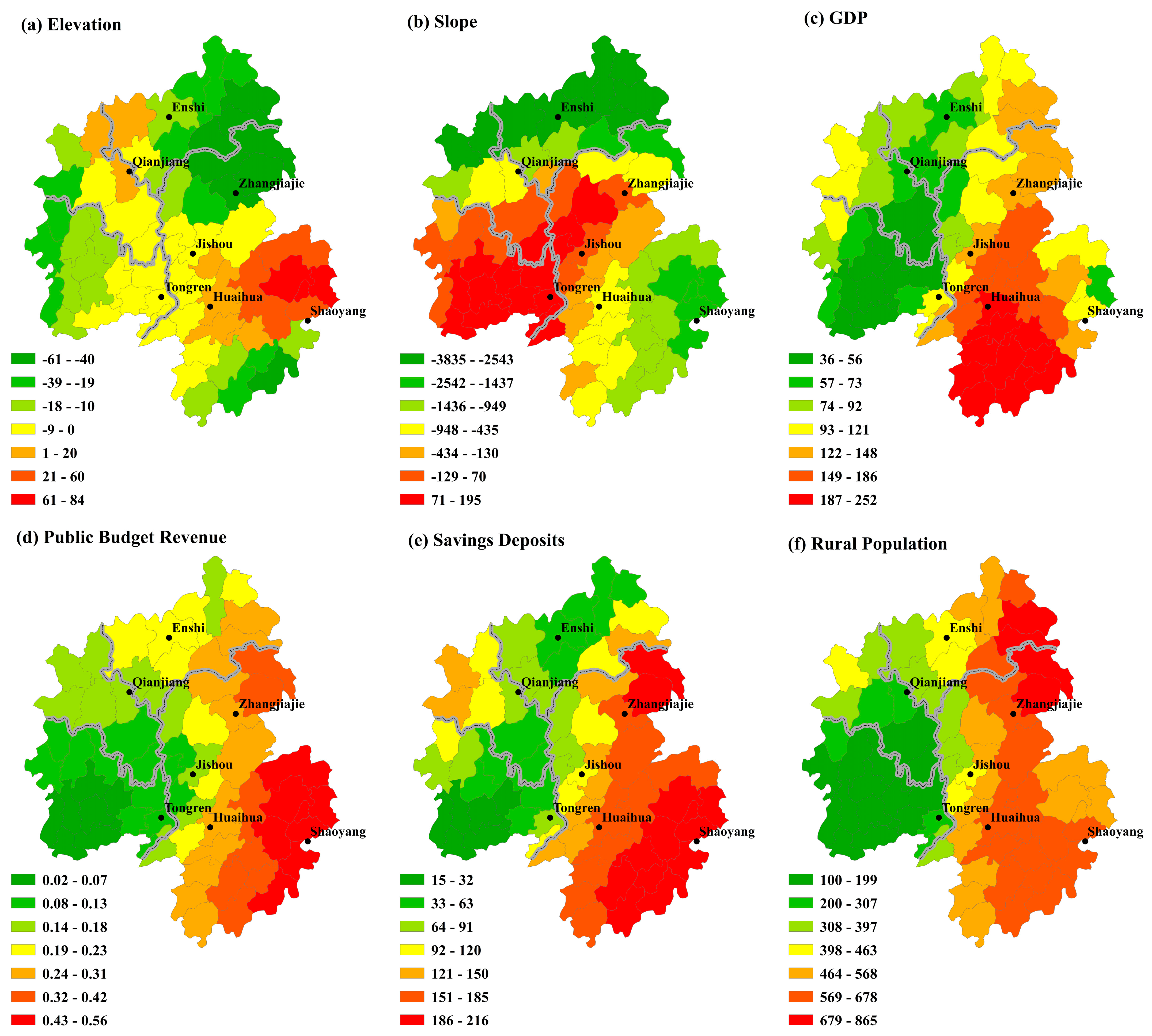
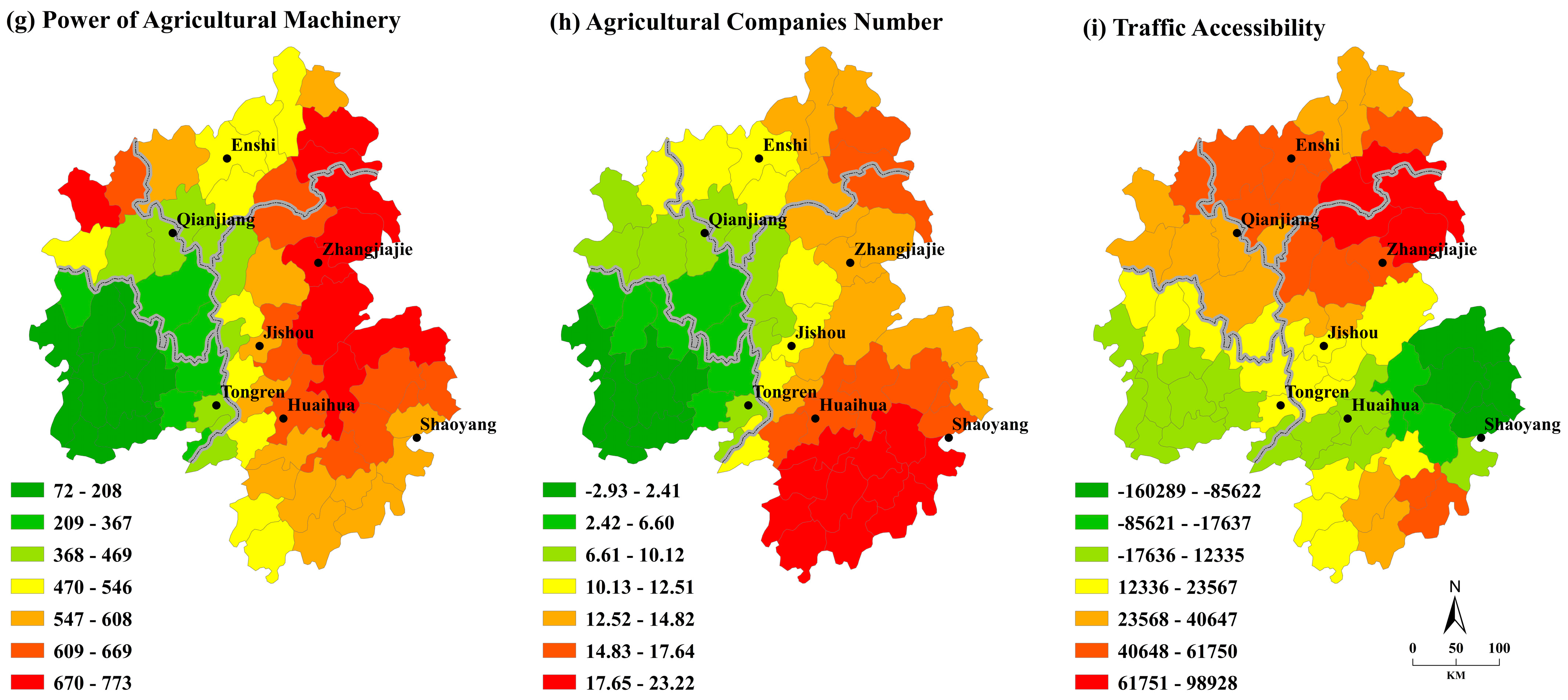
| Type of Large-Scale Agricultural Land | Criterion of Identification | Interpretation Key |
|---|---|---|
| Cultivated land | Block or strip cascade distribution, there are obvious traces of artificial cultivation Interpretation key location (109.03553, 29.708696) |  |
| Vegetable land | It is blocky or banded, mostly distributed in river valley areas, mainly planted in greenhouses Interpretation key location (108.975236, 29.624967) | 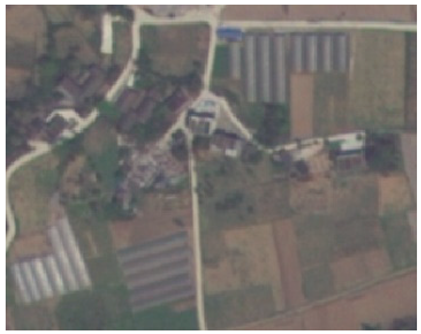 |
| Orchard land | Neatly arranged, contiguous distribution, most of them have road transport facilities Interpretation key location (111.420893, 30.631348) |  |
| Tea garden land | Strip distribution, along with the terrain in the form of steps, high canopy Interpretation key location (109.533844, 30.078978) |  |
| Primary Indicator | Secondary Indicator | Third Level Indicator |
|---|---|---|
| Natural Conditions | Terrain Conditions | Elevation |
| Slope | ||
| Production Factors | Labor | Rural Population |
| Capital | Balance of Savings Deposits of Urban and Rural Residents | |
| GDP | ||
| General Public Budget Revenue | ||
| Science and Technology | Total Power of Agricultural Machinery | |
| Management | Agricultural Companies Number | |
| Digitization | Rural Digital Infrastructure Index | |
| Rural Economy Digitization Index | ||
| Digitization Index of Rural Governance | ||
| Digitization Index of Rural Life | ||
| Location Conditions | Traffic Accessibility | Traffic Density |
| Impact Degree of Trunk | ||
| Degree of Location Advantage |
| Index | Slope | Elevation | Balance of Savings Deposits | GDP | General Public Budget Revenue |
|---|---|---|---|---|---|
| q statistic | 0.2 | 0.3 | 0.42 | 0.26 | 0.34 |
| p-value | 0.049 | 0.002 | 0.001 | 0.007 | 0.001 |
| Index | Rural Population | Power of Agricultural Machinery | Agricultural Companies Number | Traffic Accessibility | Rural Digitization Index |
| q statistic | 0.6 | 0.42 | 0.37 | 0.22 | 0.12 |
| p-value | 0.001 | 0.002 | 0.003 | 0.004 | 0.136 |
| Model Parameter | R2 | R2 Adjusted | R2(OLS) | R2 Adjusted(OLS) | Bandwidth | Residual Squares | Sigma | AICc |
|---|---|---|---|---|---|---|---|---|
| Value | 0.7801 | 0.7317 | 0.163 | 0.058 | 485,087 | 4,526,461,846 | 9012.16 | 1469.66 |
| Index | Slope | Elevation | Balance of Savings Deposits | GDP | General Public Budget Revenue |
|---|---|---|---|---|---|
| VIF | 2.620 | 2.483 | 1.528 | 3.488 | 3.135 |
| t-Statistic | 1.795 | 1.758 | 4.144 | 2.612 | 3.119 |
| p-value | <0.05 | <0.05 | <0.005 | <0.01 | <0.005 |
| Index | Rural Population | Power of Agricultural Machinery | Agricultural Companies Number | Traffic Accessibility | |
| VIF | 2.758 | 2.254 | 2.422 | 1.592 | |
| t-Statistic | 5.712 | 3.413 | 4.736 | 1.763 | |
| p-value | <0.005 | <0.005 | <0.005 | <0.05 |
Disclaimer/Publisher’s Note: The statements, opinions and data contained in all publications are solely those of the individual author(s) and contributor(s) and not of MDPI and/or the editor(s). MDPI and/or the editor(s) disclaim responsibility for any injury to people or property resulting from any ideas, methods, instructions or products referred to in the content. |
© 2023 by the authors. Licensee MDPI, Basel, Switzerland. This article is an open access article distributed under the terms and conditions of the Creative Commons Attribution (CC BY) license (https://creativecommons.org/licenses/by/4.0/).
Share and Cite
Chen, Y.; Zhang, W.; Liu, Y.; Li, W.; Liu, C.; Yang, S. Spatial Pattern of Large-Scale Agricultural Land and Spatial Heterogeneity of Influencing Factors in the Mountainous Areas of Western China—Wuling Mountains as an Example. Land 2023, 12, 2074. https://doi.org/10.3390/land12112074
Chen Y, Zhang W, Liu Y, Li W, Liu C, Yang S. Spatial Pattern of Large-Scale Agricultural Land and Spatial Heterogeneity of Influencing Factors in the Mountainous Areas of Western China—Wuling Mountains as an Example. Land. 2023; 12(11):2074. https://doi.org/10.3390/land12112074
Chicago/Turabian StyleChen, Yu, Wenhui Zhang, Yilian Liu, Weisong Li, Chengwu Liu, and Shengfu Yang. 2023. "Spatial Pattern of Large-Scale Agricultural Land and Spatial Heterogeneity of Influencing Factors in the Mountainous Areas of Western China—Wuling Mountains as an Example" Land 12, no. 11: 2074. https://doi.org/10.3390/land12112074
APA StyleChen, Y., Zhang, W., Liu, Y., Li, W., Liu, C., & Yang, S. (2023). Spatial Pattern of Large-Scale Agricultural Land and Spatial Heterogeneity of Influencing Factors in the Mountainous Areas of Western China—Wuling Mountains as an Example. Land, 12(11), 2074. https://doi.org/10.3390/land12112074





